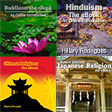Chinese Religions: The eBook
Contents
- List of Illustrations
- Chinese Dynastic History
- BCE
- CE
- Preface and Acknowledgements
- Conventions
- Introduction
- Study of Chinese Religion
- Main Religious Traditions
- Organization of the Book
Chapter 1: Early Patterns of Chinese Religious Life
- Historical Frameworks
- Oracle Bones and Divination
- Worship of Gods and Ancestors under the Shang
- Changing Attitudes towards Divinity during the Zhou Era
- Cultural Heroes and Sage-kings
- Chinese Mythology
- Mandate of Heaven
Chapter 2: The Classical Confucian Tradition
- Various Faces of Confucianism
- The Five “Confucian” Classics
- Confucius and his Times
- Teachings of Confucius
- Government Service, Cultural Virtuosity, and Pursuit of Sagehood
- Alternative Ways of Thought
- Mengzi's and Xunzi's Contrasting Views of Human Nature
- Emergence of Confucianism as Official Ideology
Chapter 3: Early Texts and the Emergence of Religious Daoism
- The Dao
- Shifting Boundaries and Permeable Identities
- Zhuangzi's Imaginative Vistas and Carefree Wanderings
- Laozi's ruminations on the indescribable Dao
- The Huang-Lao Movement and other Han-era Transitions
- The Celestial Masters and the Advent of Daoism as an Organized Religion
- External Alchemy and the Quest for Immortality
- Laozi's Transfigurations
Chapter 4: Daoist Traditions and Practices
- The Shangqing Revelations
- The Lingbao Scriptures
- Codification of Daoist Ritual
- Canon Formation and Functions of Texts
- Daoism as Official Religion
- Interreligious Debates
- Monastic Orders and Institutions
- Female Role Models and Adepts
- Internal Alchemy and Meditation
Chapter 5: Spread and Flourishing of Buddhism in China
- Buddhism as Pan-Asian Religion
- Initial Entry of Buddhism into China
- Incisive Critiques and Cultural Barriers
- Enthusiastic Reponses and Broad Acceptance
- Translation of Scriptures and Canon Formation
- Popular Scriptures and other Texts
- Philosophical Systems and Doctrinal Taxonomies
- Emergence of Buddhism as a Major Religious Tradition
- Golden Age under the Tang Dynasty
- Relationship with the State
- Buddhism in Late Imperial China
Chapter 6: Schools and Practices of Chinese Buddhism
- Monastic and Lay Paradigms
- Universal Compassion and Merit Making
- Popular Beliefs and Cultic Practices
- Schools and Traditions of Chinese Buddhism
- The Tiantai School
- The Huayan School
- The Chan School
- The Pure Land Tradition
Chapter 7: Popular Religion
- Contours and Character of Popular Religion
- Syncretism
- Unity of the Three Teachings
- Ancestors and Ghosts
- Worship of Local Gods
- Celestial Bureaucracy
- Two Popular Deities: Guandi and Mazu
- Ritual Sacrifice, Divination, and other Utilitarian Practices
- Millenarian Movements, Heterodox Sects, and Secret Societies
Chapter 8: Later Transformations of Confucianism
- Confucianism during the Medieval Period
- Neo- Confucian Revival of the Song Era
- Zhu Xi's Grand Synthesis
- Constructing Genealogy of the Way
- Revising the Canon
- Path to Sagehood
- Civil Service Examinations
- Dissenting Voices and Alternative Perspectives
- Status of Women in Confucian Society
Chapter 9: Christianity, Islam, and other “Western” Religions
- Entry of “Western” Religions into Tang China
- Early Christian Missionaries
- Jesuit Missions of the Late Ming Era
- Catholic Debates over Acculturation
- Protestant Missionaries in the Ninetieth Century
- Chinese Son of God
- Early Transmission of Islam
- Adaptation and Growth of Islam
- Acculturation and Conflict in Chinese Islam
- Islam as Diverse Minority Religion
Chapter 10: Religion in Modern China
- Historical Contexts
- Facing the Challenges of Modernity
- Revitalization of Confucianism in Republican China
- Buddhist Revival of the Republican Era
- Religious Repression under Early Communist Rule
- The Cult of Mao
- Contemporary Religious Revivals
- Intersections of Religion and Politics
- Growth of Christianity
- Buddhist Resurgence
- Appendix: Chinese Festivals and Anniversary Celebrations
- Major Chinese Festivals
- Important Birthdays and Commemorative Celebrations
- Chinese Glossary
- Bibliography


